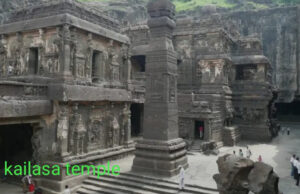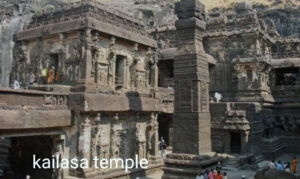Nestled in the heart of Maharashtra, India, lies the magnificent Kailasa Temple, a marvel of ancient rock-cut architecture. Part of the Ellora Caves complex, this temple is not just an architectural feat but also a significant spiritual and cultural landmark. Carved entirely out of a single rock, the Kailasa Temple stands as a testament to the skill, devotion, and ingenuity of ancient Indian artisans. This blog post delves into the history, architecture, and spiritual significance of the Kailasa Temple, offering a comprehensive overview of this remarkable structure.

1.Kailasa Temple: The Marvel of Rock-Cut Architecture
The Kailasa Temple is the most renowned of the 34 caves that make up the Ellora Caves, a UNESCO World Heritage Site. What sets this temple apart from others is its unique rock-cut construction. Unlike most temples that are built from the ground up using stones or bricks, the Kailasa Temple was hewn from a single volcanic basalt rock. This rock-cut technique is a significant aspect of ancient Indian architecture, showcasing the incredible craftsmanship of the time.
The temple is dedicated to Lord Shiva and is designed to resemble Mount Kailash, the mythical abode of the deity. The sheer scale and precision of the carving make the Kailasa Temple an unparalleled example of monolithic architecture. The temple’s complex structure, intricate carvings, and massive size make it a highlight of the Ellora Caves complex.
2. Kailasa Temple: Historical Background
The Kailasa Temple dates back to the 8th century during the reign of the Rashtrakuta dynasty, under the patronage of King Krishna I. The temple’s construction is often attributed to this king, who wanted to replicate Mount Kailash on Earth. The Rashtrakutas were great patrons of art and architecture, and their legacy is evident in the grandeur of the Kailasa Temple.
Legend has it that the temple was constructed in just 18 years, a feat that seems almost impossible given the intricacy and scale of the work. The temple is said to have employed thousands of artisans who worked day and night to carve the massive structure out of the rock. This ambitious project reflects the devotion and religious fervor of the period, as well as the technical prowess of ancient Indian builders.
3.Architectural Grandeur
The Kailasa Temple is a masterpiece of Dravidian architecture, characterized by its pyramid-shaped towers and intricate carvings. The temple is designed as a chariot, complete with pillars, shrines, and courtyards. It stands 98 feet tall, with a base area of about 276 by 154 feet, making it one of the largest monolithic structures in the world.
The temple is divided into several levels, each adorned with detailed sculptures and carvings that depict various scenes from Hindu mythology. The central shrine, which houses the lingam (a symbol of Lord Shiva) majestically above the temple, is surrounded by smaller shrines dedicated to other deities. The main tower, or shikhara, rises majestically above the temple, adding to its imposing presence.
One of the most striking features of the Kailasa Temple is the life-sized elephant statues that appear to be holding up the temple. These sculptures, along with the detailed carvings of deities, animals, and mythological scenes, demonstrate the high level of artistry and attention to detail that went into the temple’s construction.

4.Spiritual Significance
The Kailasa Temple is not just an architectural marvel; it is also a significant spiritual site. Dedicated to Lord Shiva, the temple is a place of worship and pilgrimage for Hindus. The temple’s design, which mirrors Mount Kailash, underscores its spiritual importance as the earthly abode of Shiva.
Religious rituals and festivals are held at the temple, attracting devotees from across India and beyond. The temple’s sacred atmosphere, combined with its awe-inspiring architecture, offers a unique experience for visitors seeking spiritual solace.
The temple’s carvings also depict scenes from the Ramayana and Mahabharata, two of Hinduism’s most important epics. These depictions serve not only as artistic expressions but also as religious teachings, making the Kailasa Temple a place of both worship and education.
5.Artistic Mastery
The artistry of the Kailasa Temple is evident in every inch of its structure. The temple is adorned with intricate carvings that depict a variety of Hindu deities, mythological creatures, and scenes from sacred texts. The level of detail in these carvings is astonishing, with each figure meticulously crafted to convey emotion and movement.
One of the most famous carvings is that of Ravana, the demon king, attempting to lift Mount Kailash while Lord Shiva calmly sits atop it. This scene, carved on the southern wall of the temple, is a masterpiece of composition and execution, capturing the essence of the mythological tale.
The temple’s sculptures also highlight the influence of different art styles, including those from the Pallava and Chalukya dynasties. This blend of artistic traditions adds to the temple’s cultural richness, making it a valuable piece of India’s artistic heritage.
6.Myths and Legends
The Kailasa Temple is steeped in myths and legends, many of which add to its mystique. One popular legend suggests that the temple was built in a miraculous manner by a queen who vowed to fast until the temple was completed. According to the story, the temple was constructed within a week, a feat attributed to divine intervention.
Another legend speaks of a master architect who, upon seeing the massive rock that was to be carved into the temple, exclaimed, “If this rock can be turned into a temple, it will be the work of the gods themselves.” These legends, passed down through generations, contribute to the temple’s allure, making it not just a monument but a living part of India’s cultural narrative.
7.Tourism and Cultural Impact
Today, the Kailasa Temple is a major tourist attraction, drawing visitors from all over the world. Its inclusion in the Ellora Caves complex, a UNESCO World Heritage Site, has further cemented its status as a cultural and historical treasure. The temple’s unique architecture and rich history make it a must-visit destination for anyone interested in India’s ancient heritage.
The temple’s cultural impact extends beyond tourism. It has inspired countless artists, writers, and historians, contributing to a deeper understanding of India’s architectural and artistic traditions. However, the temple also faces challenges in preservation, as natural erosion and human activity take their toll on the ancient structure. Efforts are ongoing to protect and restore the temple, ensuring that it remains a beacon of India’s rich cultural legacy.
Conclusion:
The Kailasa Temple stands as a testament to the brilliance of ancient Indian architecture and the deep spiritual devotion of its creators. Its awe-inspiring structure, intricate carvings, and rich history make it a symbol of India’s cultural heritage. Whether you are an architecture enthusiast, a spiritual seeker, or a history buff, the Kailasa Temple offers a profound and enriching experience. Visiting this temple is not just a journey through history but a pilgrimage to one of the most remarkable achievements of human civilization.
FAQ:
1.Who built the Kailasa Temple?
2.What is special about Kailash Temple?
3.Why is Kailasa Temple mysterious?
4.Which God is in Kailasa Temple?
5.Kailasa temple history
6.Kailasa temple mystery
7.Kailash temple at Ellora was built by

